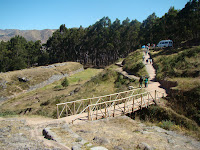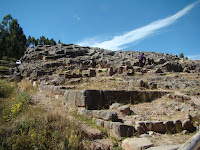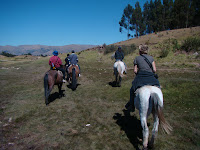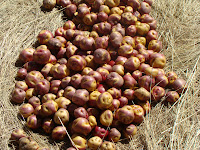
On our last visit to Peru we visited the Sacred Valley and the adjoining town of Pisac, which isknow for its handicrafts and markets on Sundays. We decided that we had to go back - for a short shopping expedition!!! This turned out to be a full day expedition.
(Left - Liz, Gerard, Amanda and myself on the road overlooking the Sacred Valley)
Public Transport is not that prolific in Peru, so to get to Pisac it was a matter of arranging a taxi, which we did through the office. At 9.30am our cab arrived with a pre-arranged fare (again the norm in Peru to pre-arrange as there are no meters). Our fare was 60 Soles (about Aus dol 25

for the 1 hour trip.
(Right - having our own cab meant that he would stop for photos if necessary - here high above the valley floor)


(Left - this area was hit very hard in the recent mud slides - this is part of the remains of a village which took the full force)
 (Right - further up the valley is where the mud slide actually started - tearing away the whole cliff side)
(Right - further up the valley is where the mud slide actually started - tearing away the whole cliff side)















 (Right - further up the valley is where the mud slide actually started - tearing away the whole cliff side)
(Right - further up the valley is where the mud slide actually started - tearing away the whole cliff side)
(Left - reaching Pisac, the entry is via a narrow bridge across the river)

(Right - it is not only narrow - it is 2 way!! Which makes for polite drivers)

(Left - we had a morning cup of tea and later our lunch at a place called the Blue Lama - they had wonderful decorations around the wall)

(Right - Amanda, Gerard and Liz in the Blue Lama)

(Left - Not only are the restaurant walls decorated, but so are the toilet walls - have a look at these -women's on the left)

(Right - decoration on the wall in the men's toilet!!)

(Left - the market at Pisac covers fruit and vegetable as well as handicrafts)

(Right - the market covers the whole square, and is set up each Saturday morning, and dismantled that evening. It is mostly covered)

(Left - one of the market lanes - note the channel in the middle of the path - for heavy rains)

(Right - as well as normal knitted and manufactured handicrafts there are a number of shops selling paintings - and they are very nice)

(Left - in one shop Liz, Amanda and Gerald haggle over a price)

(Right - Gerald haggles over some socks - would up with four pairs in the end)

(Left - Liz tries to negotiate a better price)

(Right - as you can see our day was quite successful - in supporting the Peruvean economy)

(Left - on the journey home - we negotiated a fare with another cabbie of Sol 35 - almost half the price of the morning's cab - but we think his last job was speed way driving as he kept the same speed ALL the way home - corners and all!! But we did see some of the un-repaired parts of the road - result of the earlier mud slides, which narrow the road to a single lane!)























 Having finished the inspection of the Inca ruins here, it was back to the horses (who had waited patiently), and set off down the hill - perhaps with a little more confidence this time.
Having finished the inspection of the Inca ruins here, it was back to the horses (who had waited patiently), and set off down the hill - perhaps with a little more confidence this time.







